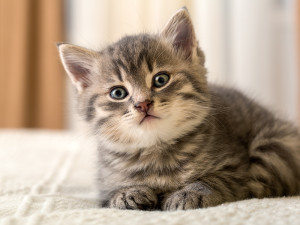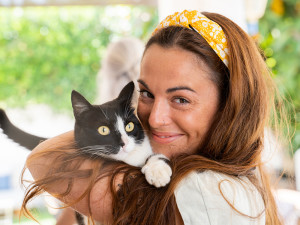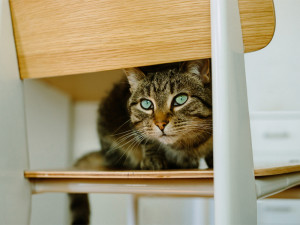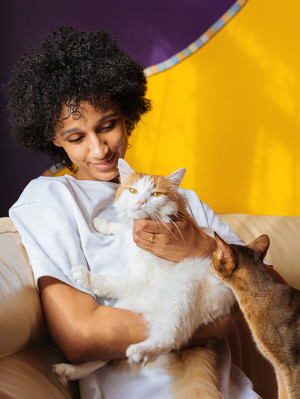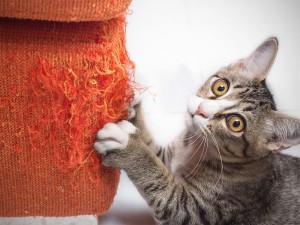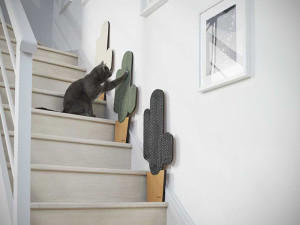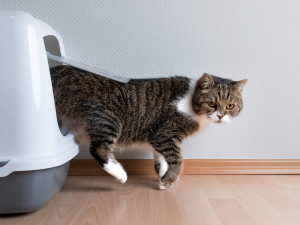5 Kitten Behavioral Milestones You Should Know
Keep track of all their fun phases with these guidelines.
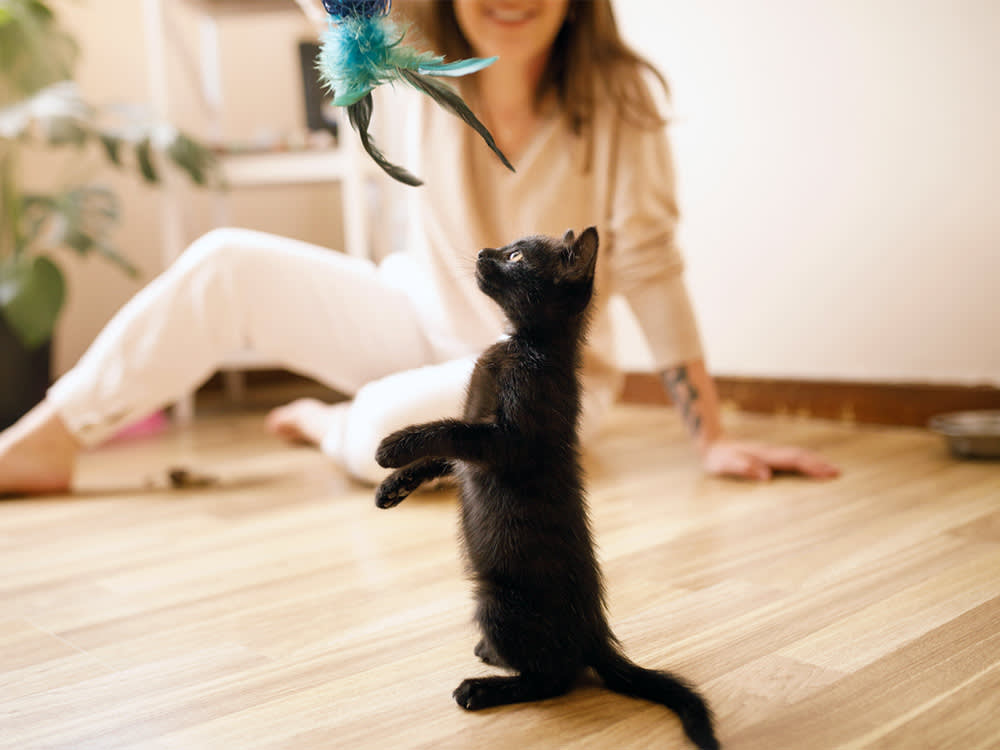
Share Article
Kittens develop in stages, and each stage has predictable behavior. OK, not totally predictable because cats haven’t read the books about their own growth stages, and they don’t always know what we are counting on them to do. With that disclaimer, their age and developmental stage are hugely influential in how they act and what they do. That’s good news, because knowing what to expect makes it just a little easier to raise kittens and provide what will benefit them at any point in their young lives.
Zero to two weeks
What to expect
During the neonatal phases, kittens are completely dependent on their mom. They need to be with her for food, for warmth, and for comfort. During this stage, besides eating a lot, expect your kitten to sleep a lot, because those are their main two activities in these early weeks. Their eyes open at about two weeks and then they look around a bit. They will start orienting to sounds during the latter part of this phase.
What to do
In these first few weeks, leave kittens with their mom and with their littermates. That is where kittens need to be for their development as well as for their comfort and feeling of safety. They learn how to interact with other cats as well as how to inhibit their bite from their littermates.
If they are taken from their littermates and mother before learning these important life lessons, it is very difficult for them to learn these skills. If you must handle them for any reason, do so briefly, and with the utmost of gentleness. Other than that, the main job of anyone responsible for kittens at this age is to keep the area clean and warm.

Two to seven weeks
What to expect
During these early weeks, kittens will see their mother and purposely walk toward her. Their walking skills continue developing until they become quite good, and they can even run. They avoid obstacles as they move about and will begin stalking and also pouncing on objects. It’s during this stage that they start to interact with their littermates and to explore on their own. Kittens engage in grooming at this age. They are frequently more open to new experiences, situations, types of handling, and sounds during this time than at any other time in their life.
What to do
It’s absolutely critical to socialize kittensopens in new tab while in this stage, as during this time, their brains are better able to accept new experiences, situations, and other species as normal than at any other time in their lives. Only during this time can a few positive experiences be so influential in teaching a cat to be OK with something now and for the rest of their lives.
Socialization helps kittens develop positive associations with the things they will encounter throughout their lives. Those “things” include people, dogs, and other cats as well as the sounds and objects so common inside and outside the house, different types of walking surfaces, and a variety of smells.
The key is to provide a lot of positive experiences for your kitten with all sorts of people, objects, and experiences. That is not the same thing as simply exposing your kitten to a variety of experiences. Good socialization involves good experiences, not just varied experiences. Kittens who are well-socialized are more likely to develop into adult cats who do well with other cats, dogs, children, adults, and being handled. Never overwhelm or frighten your kitten.
The socialization period for kittens is much shorter than it is for puppies, and in fact, is often largely over by the time kittens go to their new homes. That is why it is so important for those raising kittens to focus on socialization before their kittens leave their mom and their litter.
During this time, handle them gently and have other people do the same. Introduce them to other pets, multiple people, all the rooms in the house, kitchen appliances, fans, alarms, car rides, their veterinarian’s office and the people who work there. Start basic grooming, such as nail trims (start with one at a time to make it easy for your kitten to handle) and gentle brushing, to a collar, and perhaps to a harness and leash. Always use great treats and be very gentle to make these experiences positive.
Begin training by teaching kittens to touch a target, to sit, and to use the litterbox, which they may have already learned to use. Teach them to play with toys. Train them not to play with hands, feet, hair, or any other human body parts by redirecting their attention to toys if they attempt to play with any part of your body. That is essential to avoid bites and scratches, however playfully intended, now and when they get older and stronger. Begin to teach them to be comfortable in a cat carrier.
Seven to 14 weeks
What to expect
Just as real estate agents say the three most important things about a house are location, location, location, the three biggest aspects of a kitten’s behavior during this stage are playfulness, playfulness, playfulness. Oh, and did I mention they tend to be very playful during this time?
Kittens at this age are often super into playing with toys and other objects, with other kittens, and with people. They typically do lots of pouncing, chasing, leaping, and pawing at objects. They will chase their own tails and those of other animals including their littermates. They may try to play with people’s hands, feet, hair, and clothing, or anything else that moves or otherwise captures their attention.
They become increasingly coordinated and fast at this age and groom themselves more regularly. They also start scratching at whatever is available, whether that is your couch or a designated scratching post.
What to do
During this time, continue activities related to socialization. The window on its effectiveness is closing, but kittens need continued exposure in a way that offers them positive experiences to people, cats, dogs, surfaces, sounds, appliances, and everything else they are likely to encounter throughout their lives in order to grow up as sociable and well-adjusted as possible.
Continue to play with them a lot — multiple times throughout the day! — but use toys and not your hands or feet in order to avoid bites and scratches, both now and later. Continue to redirect their attention to toys as it will likely take them a long time to learn this lesson well.
Continue training your cat so they are comfortable walking on a leash, sitting when you ask, and using the litter box, though most cats will be litter box-trained by now. Work on training them to come when called, to high-five, to go through a tunnel, to go to their bed, or any other skills you want them to have. Take them for rides in their cat carrier and have them practice entering and being lifted up in their cat carrier. Take them for visits to the veterinarian, but don’t make every car ride a trip there. Use treats and play to make everything a positive experience.
Continue to practice grooming by brushing them, trimming their nails, and perhaps cleaning their feet. Always associate these happenings with great treats and with a gentle touch. It’s counterproductive to overwhelm or frighten your kitten. Provide scratching posts so they scratch there instead of objects in your house you’d rather stay unscathed by kitty nails.
14 weeks to 6 months
What to expect
Kittens at this age show increasing energy levels and more curiosity about their world than before. They tend to explore more, climb all over the place, and do more leaping around, including from one high spot to another.
They are more likely than before to attempt to explore even where you do not wish them to go, so your window coverings and any shelves may become part of their playground. It’s typical for the grace and coordination of their movements to improve during this time as they leave kitten clumsiness and irregular movements behind and instead start to move in a more sleek, graceful way. They often become more vocal during this time.
They continue having a huge interest in play, both object play and social play. The object play will often look a bit like predatory behavior, and the social play tends to have similarities with fighting. Engage your kitten in lots of play and allow them to play with other cats in the house as long as everyone is having a good time and it’s appropriate play that isn’t out of hand.
What to do
Kittens at this stage need lots of enrichment in the form of physical and mental exercise. Play with them a lot and give them opportunities to play with any other gentle social members of the household. Offer them ways to explore the house with high perches and kitty condos. Take them for walks on leash if you plan to make such excursions a part of their life. Provide scratching posts and lots of toys to keep them entertained and occupied.
Give your kitten attention in ways beyond play with grooming, training, and petting. If they find you and the house interesting, they will be a little less likely to try to escape the house for adventures on their own, which are important to prevent for the sake of safety.
In terms of training, now is a good time to continue working on sit, tricks, and wearing a leash, harness, and collar. It’s also important to practice having your kitten enter a cat carrier willingly and going for rides, including to the veterinarian. Associate handling of all kinds, including grooming, with treats to keep these experiences positive for your kitten. Brief sessions of 15 to 30 seconds with brushing or being picked up and receiving top quality treats help kittens learn to like these activities.
Six months to a year
What to expect
At this stage in their lives, kittens are adolescents and changing fast, so new behavioral developments often take people by surprise, and they perceive what their kittens do as unpredictable. Felines at this age are transforming from kittens into cats, so there is a lot of change. Remember to expect the unexpected as your kitten develops — but especially during this stage. Sometimes, our brains still anticipate kitten-ish behavior when more adult-like behavior is more likely.
During this period, kittens become a lot more independent. They explore more and exhibit greater levels of adventurousness. They often have stronger preferences about which toy to play with, where to rest, whether they are in the mood for physical contact from you, and what treats or other types of food are worth eating. It’s common for cat parents to exclaim during their kitten’s adolescence, “They have a mind of their own!” Of course, that’s as it should be: After all, whose mind should they have if not their own?
What to do
A good strategy for continuing to develop a strong relationship between pet parents and kitten during this stage is to respect the cat’s boundaries. If they don’t share your interest in cuddling or petting, let them be. If they turn down your invitation to play or don’t embrace today’s training plan, that’s fine. Interact with them when they are into it and don’t push them when they are not. That will do more to enhance your relationship and encourage more interaction from them in the future than any sort of coercing or pushing, no matter how gentle.
Take advantage of their interest in interacting whenever they happen to show it. Whether they initiate or welcome your invitation to play or train, or whether they are agreeable about grooming or handling, just go with it. Remember, they were once revered as gods in ancient Egypt, and the level of respect that merits doesn’t ever change.
They still need and probably want a lot of interaction with you, so be flexible about when and how to interact. Many kittens are very snuggly during this stage, but others far less so. Follow their lead about what they enjoy. Offer them playtime, new toys, scratching posts, places to climb and high perches, and spend time training them.
The specific games you play and the specific skills you teach them are less important than the positive interactions and the opportunities to use their brains and the rest of their bodies in fun, interesting, and satisfying ways. Continue brushing them and handling them regularly, play with and train them every day, and practice getting them in their carrier and taking them for rides while in it.
One year to two years
What to expect
At the age of a year, kittens are generally considered adults, but they are such young adults and so recently out of adolescence that you will still see behavioral changes in the second year of life. They remain playful but are often a bit calmer in general than they were in their first year, though that varies cat to cat. Some cats don’t show any signs of less activity until they are even older.
What to do
This is the stage at which it’s important to continue giving lots of attention to your cat. They may be a little less demanding about attention, and the devil may not be as likely to find work for their idle paws, but they still want and need a lot of attention and activity. They are very young and active and benefit from lots of activity.
Continue to play with them every day, multiple times, using toys and not your hands, feet, or hair. Offer them new toys regularly, and rotate their toys so they don’t get bored of them. Give them lots of opportunity for exercise by taking them for walks and investing in cat condos and tunnels.
Pet and cuddle them on their own terms, never forcing them, but doing so when they are interested in and welcome such interactions. Continue, as always, to be gentle with your cat when grooming and picking them up. Use treats to make those experiences positive for them, and do the same for cat carrier training and rides in their carrier.
Keep training your cat; training does so much more than lead to a well-trained cat. Training also offers a lot of fun mental and physical activity and is an enjoyable way to interact together, all while enhancing your relationship. Cats can be trained to perform many skills such as to spin, to sit, to high-five, to touch a target, to fetch, to come when called, and to jump through a hoop. Your creativity and their natural movements both contribute to the skill set they develop through training.
Take these for what they are: guidelines
Of course, if they’re anything, cats are individuals, so take these stages as general guidelines rather than as absolutes. These kitten stages describe the general pattern most kittens follow as they grow up, and knowing about them can add to your confidence as a cat parent when it comes to what to expect and do, behaviorally speaking, at each stage of a kitten’s life.
Thinking of kitten development in phases is a way to make understanding their behavior easier, which makes raising them easier. It’s simply more fun having a kitten in your life if the changes in behavior you see don’t all come as a huge surprise. It’s better to avoid any shock about your kitten’s behavior and let the surprises come from just how endearingly charming they can be — at every stage.

Karen B. London, PhD, CAAB, CPDT-KA
Karen B. London is a certified applied animal behaviorist (CAAB) and certified professional dog trainer (CPDT) who specializes in working with dogs with serious behavioral issues, including aggression. She has written for a variety of magazines including The Bark, Clean Run, and the APDT Chronicle of the Dog, and has published in scientific journals including Behavioral Ecology and Sociobiology, Ethology, Ecology, and Evolution, the Journal of Insect Behavior, and Insectes Sociaux. She is the author of seven books about dog training and canine behavior, including the forthcoming My Dog's Mystery Adventure: And Other Stories From a Canine Behaviorist and Dog Trainer.
Related articles
![Grey cat sitting on on stairs scratching at the cactus shaped Meyou Paris Vegas Scratcher]()
The Best Cat Scratching Posts, Pads and Everything in Between
Your cat’s claws are out. Do you have scratchers at the ready?
![Cat sitting in a teal litter box]()
How to Train a Cat to Use a Litter Box
If you do nothing else, teach your cat to poop in their litter box (not your shoe).
![cat coming out of litter box]()
What to Do When Your Cat Refuses to Be (Litter) Boxed In
An expert explains why kitties are so particular about where they pop a squat.
![Black cat staring at a cat toy]()
How to Play With Your Cat
Cat behaviorist Cristin Tamburo’s got a game plan.

